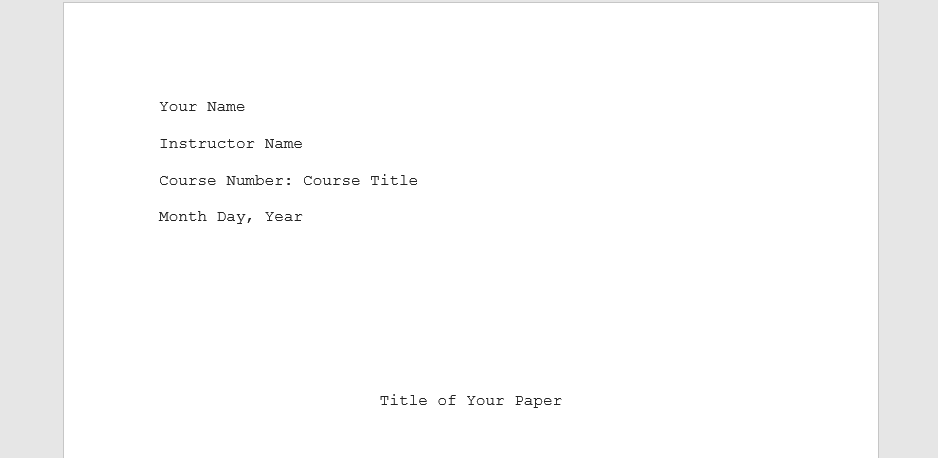You might not think of your essay’s cover page as necessary. After all, its primary role is just to identify who wrote the paper. However, a cover page does more than provide your name and essay title. It also demonstrates your ability to master the particular style guide for your essay. That may seem simple, but writing according to specific rules can be very important. For lower-level academic papers, it shows that you can master simple rules. For higher-level academic essays, it ensures that your documents are formatted correctly for publication.
In this blog post, we will take you step by step through the process of writing a cover page. We will cover the most common academic style guides so you can rely on this blog for your paper. Of course, you should always double-check your professor’s instructions. Some will tell you to deviate from the style guide with specific instructions.
What Is a Cover Page?
A cover page is the first page of a paper. It is also known as a title page. It contains basic identifying information, such as your name and the title of your article. It may have additional identifying information, as well, including
- Title of the Paper
- Author’s Name
- Course Information
- Date of Submission
- Institutional Affiliation
You may not be required to include a cover page. Sometimes, all a professor requires is identifying information in the header or footer of your essay. However, cover pages are necessary for most formatting styles. If so, you want a cover page that complies.
View 120,000+ High Quality Essay Examples
Learn-by-example to improve your academic writing
Types of Cover Pages
Each style guide dictates a particular type of cover page. The three most common ones you will encounter are
- MLA
- APA
- Chicago/ Turabian
If you are using another style guide, consult it for specific information on that type of writing.
MLA
If you are using MLA style, you may not need a cover page. Generally, they are optional. In fact, the preference is for you to include that information at the top of the paper’s first page instead of on a separate cover page. However, you should use a cover page if you have multiple authors. In addition, if your professor requests a cover page, you should include one.
You put most of your information in the upper-left corner of an MLA cover page. You have one-inch margins all around. The information is double-spaced.
The first line is the author’s name. If there are multiple authors, each has their own line.
After the authors’ names, write the instructor’s name. You want to use their formal title. For many professors, that will be something like Dr. Smith. However, if they are not a doctor, use the title Professor.
The following line should be the name of the course, including the course number.
Finally, finish off the information with the date. For MLA format, you can do day-month-year or month-day-year. However, it would help if you fully spelled out the month.
Use four or five double spaces to locate the page’s approximate middle. Write the paper’s title. Unlike the above information, this will not be on the left. Instead, you will center it. The title should be in the same font you use for the rest of the paper or title page, with no bold, italics, or quotations unless you reference another work’s title. Capitalize using standard capitalization rules.
MLA Format Essay Cover Page Example
John Smith
Dr. Hazlett
English 203: Introduction to Shakespeare
October 1, 2023
The Victimization of Ophelia
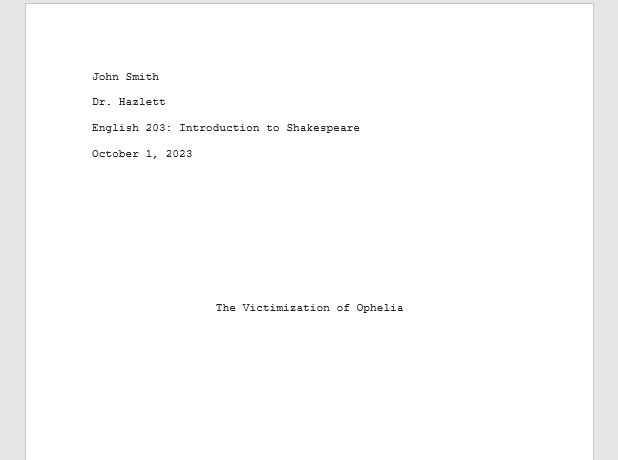
MLA Format Essay Cover Page Template
Your Name
Instructor Name
Course Number: Course Title
Month Day, Year
Title of Your Paper
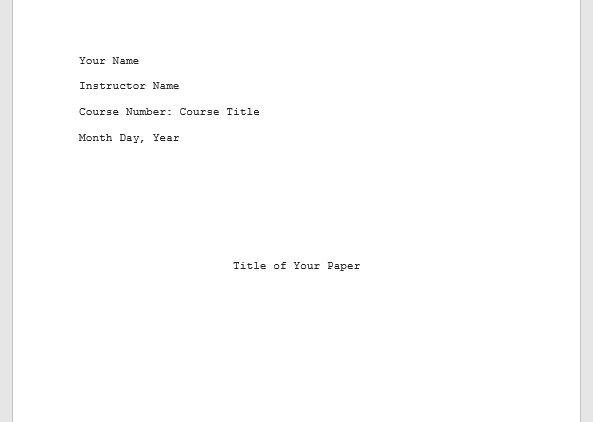
APA
In APA style, there are actually multiple formats for cover pages. So, the structure differs slightly if you are writing a professional paper. Plus, some publications may have their own rules. These instructions are for documents written by students.
The margins should be one inch on all sides.
Number the cover page with the number one. It should go in the upper-right corner of the page. It should be right justified at the one-inch page margin. In your word processing format, it should go in the header.
Double-space three or four lines from the top. Center the paper’s title. It should be in bold. Use standard capitalization rules.
Double space once, leaving a single blank space between lines. Use the author’s name. If multiple authors exist, join them using commas and/or the word “and.”
On the following line, write the department, then the school name. Use a comma to separate them.
On the following line, write the course name, including the course number.
On the following line, write the instructor’s name using their title.
Finally, on the last line, write the date. Although APA does not require you to spell out the month, it is a good idea to write the month’s name for clarity’s sake.
APA Essay Cover Page Example
Selecting a Shelter Dog
Mark Smith
Animal Science Department, Texas A&M University
Animal Science 403: Companion Animals
Dr. James Goodyear
October 2, 2023
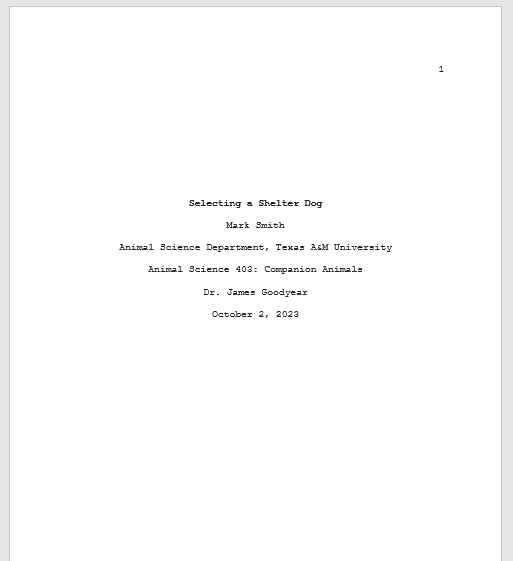
APA Essay Cover Page Template
Title
Author Name
Department, School Name
Course Number: Course Title
Instructor Name
Month Day, Year
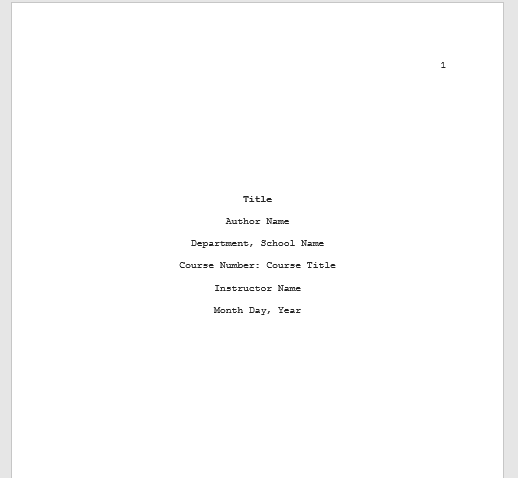
Chicago
You may hear people refer to Chicago or Turabian style. That can become confusing. However, Turabian refers to a writer who simplified the style guidelines for the Chicago style. Chicago and Turabian styles are essentially the same.
In a Chicago-style cover page, you center all of the information. None of it is left or right justified.
The first line on your cover page is the title. It would help if you located it about one-third of the way down the page. If you have a subtitle, include a colon after the title, then place the subtitle on the following line.
Leave several blank lines before you begin the following information.
Include your name.
Place your course number and then the course title on the following line.
Follow it with your professor’s name and professional title on the following line.
The final line should have the date. The format should be month, day, and year.
Chicago Style Essay Cover Page Example
A Psychological Exploration of Sexual Serial Killers:
Why Dahmer and Bundy Are Less Alike Than We Think
Susan Smith
Psychology 405: Abnormal Psychology
Dr. Hannah Hardaway
October 1, 2023
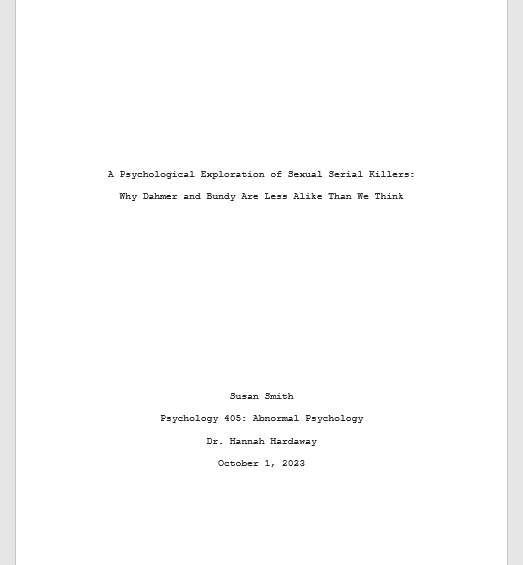
Chicago Style Essay Cover Page Template
Title:
Subtitle
Name
Course Number: Course Title
Instructor Name
Month Day, Year
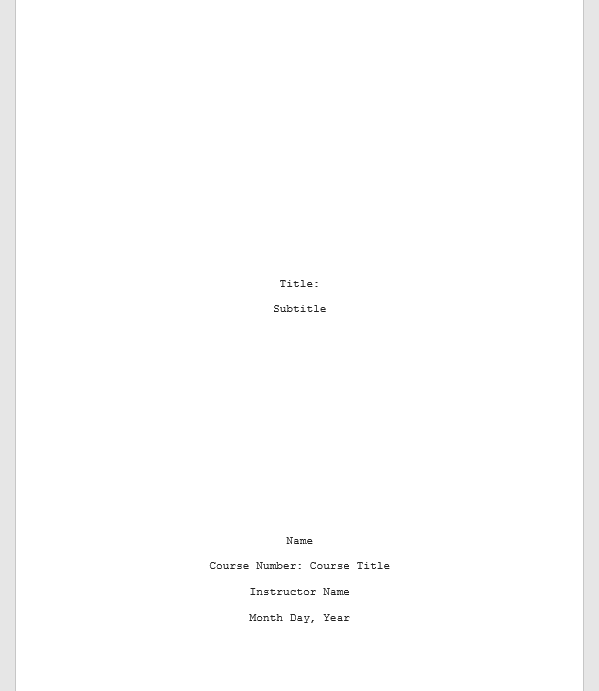
Formatting Guidelines for a Cover Page
Format for a cover page follows many of the same rules as the formatting for the rest of the paper.
For MLA format, you should use a 12-point font that is easy to read. The preferred default font is Times New Roman. You should have one-inch margins. The information at the top should be left aligned. The title should be centered. You should double-space the data, leaving space between the identifying information and the title. Do not use bold or italics unless you are using italics to signify the use of a title in your title.
For APA format, you should use a 12-point font that is easy to read. Like MLA, the preferred default font is Times New Roman. You should have one-inch margins. APA contains a Running Head for some papers. Even without a running head, you should include a page number in the top right corner of the header. You center all information on the APA cover page. Start with the paper’s title midway down the page. Use double space. The following lines should contain the following information:
- Author’s names
- Department and school name
- Course number and name
- Instructor’s name with title
- Date
In APA format, you put the title in bold.
The Chicago style does not designate a font. However, Turabian suggests using 12-point Times New Roman or 10-point Arial. Everything on the title page is centered. You place the title one-third of the way down the paper, put several blank lines, and then add your identifying information. You do not use bold or italics on your cover page unless you are using the title of someone else’s work on your cover page.
Tips for Creating an Effective Cover Page
The first step for creating an effective cover page is coming up with a compelling title. Your title should help support the purpose of the paper. You want it to be short enough to be easy to read and understand. However, you want it long enough to help the reader understand what the paper will cover. You can use subtitles to provide additional information to the reader.
To make your title catchy, you want it to be credible, well-structured, active, accurate, and brief.
Your cover page should be in the same style as your paper. This is important because, even though they contain the same information, you will lose points if you use a different style. You will also lose points if you fail to include all the necessary information, so ensure you pay attention to detail. Once you format it, look at the cover page. Does it look neat and professional? If not, can you alter it and still follow the formatting rules? If you can, then you do want to change it. It should look professional.
Importance of a Well-Designed Cover Page
You might think of a cover page as unimportant. After all, it does not contain any of your writing. Instead, it is just a collection of identifying information. So, why are they important?
The main reason is that they prove you can follow directions. You would be astounded at how much of higher education is just demonstrating that you are capable of following multi-step instructions to get the desired outcome. Ignoring the instructions is not creative or rebellious; it just makes it seem like you are incapable of following those instructions. So, demonstrating that you can follow those instructions to create an appropriate title page makes an excellent first impression on the reader. They can see that you can understand and synthesize information, using it to create something new.
In fact, it would be fair to say that a proper cover page makes your writing seem more professional. While we have focused on student papers in this article, it is essential to keep in mind that there may be different rules when you submit an article for publication or other professional use. Following the appropriate guidelines helps demonstrate your professionalism.
A cover page also helps you organize and present information. Most cover pages contain the same information but have you present it in slightly different ways. Following the prescribed format is a way to help you organize and submit it.
A cover page can enhance the overall presentation of your essay. They provide a clear delineation between the title information and the paper itself. It gives an edge of professionalism. So, it is an excellent way to start your essay.
Conclusion
Designing a cover page is not difficult. Each style has its own format for cover pages. We have even included templates in our examples, which you can use to plug in your information. The result should be a properly formatted cover page in your chosen format. So, there is no reason for your cover page not to meet standards.
It can seem daunting to look up the information and properly format a cover page. Back in the day, when style manuals were on paper, not online, you might even struggle with how to format them. However, now you only need to invest a little time and effort to create a well-designed cover page. Suppose you have any questions about your cover page. In that case, significantly if it deviates from the example in any way, you can always contact us. We are happy to answer any questions that you may have.
While your cover page may not seem to add much to your essay, it really helps you make a great first impression. That is a great thing. Think of your cover page as setting the tone for the reader about consuming your paper or essay. A professional cover page that complies with all of the requirements sets the tone that your report will be professional and meet all requirements. That may make your instructor less likely to grade you harshly.
On the other hand, a messy and disorganized cover page that ignores the instructors is a red flag. It will signal to the reader that you are unable or unwilling to follow instructions and make them more likely to look out for other errors in the paper. So, invest a few extra minutes to write a great cover page. If you have any questions about format, please feel free to contact us. We are happy to answer outstanding questions. We can also review your cover page or other parts of your essay to ensure that you are complying with the proper formatting instructions.

